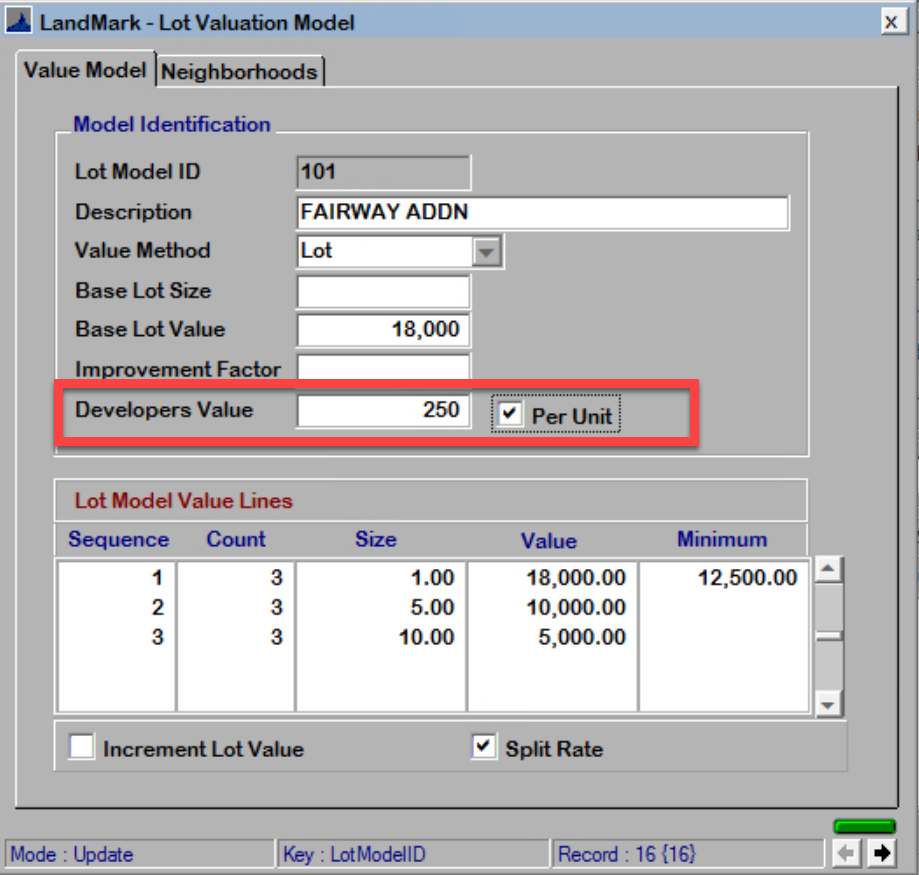To view or edit the Lot Model Table from the Appraisal Module, go to Tables — Land Tables — Lot Model Tables
Go to Lot Model Table Example for a video and in depth teaching on Lot ModelTables.
General thoughts on Lot Models
- In mass appraisal uniformity is important. Adjustments from a Lot Model Table help make equality across the board than individual parcel adjustments.
- Lot Models can span multiple neighborhoods, but must be linked to the neighborhood.
- In each neighborhood, user may have a land factor that would only affect this Lot Model in that neighborhood.
- If user doesn’t define an adjustment, they won’t get an adjustment.
- Lot Models can be used in conjunction with ag land (if soil types are shown in Ag Land Table on Land Data tab).
Helpful Hint: When user makes changes in the Lot Model Table, it DOES NOT change the land values in the Land Data Tab. User must make an Index for that Neighborhood. In the Index go to Tools — Recalc File and that will apply the updated Lot Model to the Index.
To view or edit the Lot Model Table from the Appraisal File go to, Tables — Land Tables — Lot Model Table
The Lot Model Table will open.
After making a change to the lot model, use the Apply tool A confirmation box will ask you to confirm you want to do this.
After a change to the lot model or appraisal zone is done that will affect appraisal values the Apply menu option should be selected to update the records.
Lot Model ID: This is a system assigned number.
Description: The description of the lot model
Valuation Method: This is the type of units used to value the land. The options to value land are Acre, Adjusted-Lot, Front-Foot, Lot, Square-Foot, or Units-Buildable.
Base Lot Size: If there is a base lot size it can be entered here, but one is not necessary.
Base Lot Value: The base lot value for the lot model can be added if there is one.
Improvement Factor: Improvements can be factored for each lot model.
Developers Value: Newly platted land can have a developer’s value added to it. If the Developer’s deferment box is checked (In the Base Values Tab), it will by default use that land value.


If the Developer Deferment Box is checked, when the property sells, user will be asked if it is transferring out of a developer’s ownership. If it is, this flag is removed and the value will go to a market value.
Lot Model Value Lines: This is the value of each lot model. For example, if a parcel has a size of 2 acres, the first two acres can be values at $3,500 while everything after that is valued at $1,500.
Check Boxes (Control how lot models are applied)
Increment Lot Value: When checked, (if there are multiple rates) the system will NOT interpolate the value. (Not used often.)
Example: If the first line is one unit at $3000, and the second line is five units at $2000. A three units will be valued at $2000. (It will not use $3000 for the first unit. It simply returns the unit value for the number of units.)
Split Rate: When checked, (if there are multiple rates) the system applies one value to the first unit and different value to subsequent units. Most counties use this one.
Neighborhoods Tab
This shows all the Neighborhoods linked to this Lot Valuation Model
Lot Model Tables are assigned in the Appraisal File — Land Data Tab — Lot Value Model (DropDown Arrow to choose)







Post your comment on this topic.